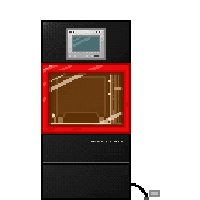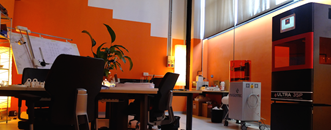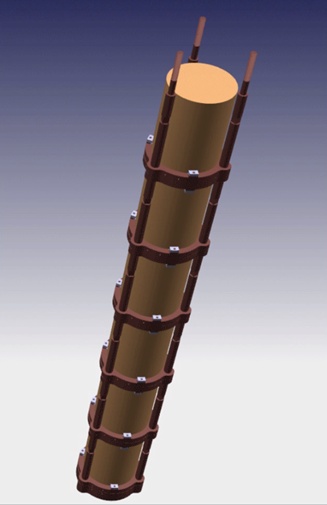
Starting from a computer-drawing, the 3D printer uses resins to build components for an experimental apparatus.
In the LNGS mechanical workshop some components required by the experiments, for example supports used in the detectors, are produced with a 3D printer. The project and the pattern of the objects are designed with a computer, which provides a three dimensional model decomposed in many thin layers. These ‘’mounting instructions ” guide the 3D printer to lay, one layer at time, a liquid resin which solidifies when exposed to a laser beam.
A Unlike in the game, the mechanical workshops and the 3D printer at the Laboratori Nazionali del Gran Sasso (LNGS) of the INFN are in reality not located in the underground tunnels, where the experiments are performed, but in the external site, where also offices and workshops are located (Fig. 1).

Fig.1 The LNGS mechanical workshops. The 3D printer is in the foreground on the right of the photo, (Image Credits: LNGS)
I The components created in the mechanical workshops with a 3D printer are used for the Xenon1T, SABRE and CUPID experiments. For the latter, for example, the supports of the towers of crystals (Fig. 2) that form the detector were “printed” as mockups. The 3D printing technique used at LNGS is laser stereo-lithography. This allows us to translate the data directly into real three-dimensional objects, processed by a CAD program (Computer Aided Drafting – computer-aided technical drawing; this is the software used, for example, by architects to design buildings, or by engineers to design engines). In a 3D stereo-lithography laser printer the virtual three-dimensional model of an object is divided into many thin sections. These sections, produced in sequence, are made by moving a laser beam driven by the CAD software along a fixed solid surface, below which a photo-polymerizable liquid resin is present. The laser, which moves according to the structures of the virtual model, interacts with the resin triggering a chemical reaction (photo-polymerization) that fixes it, thus generating the thin section desired. At the end of each laser scan, the plate lowers slightly and proceeds with the next scan, and so on, until the complete component is obtained. Each time a thin section is constructed and fixed onto the previous one. Finally, the object is extracted from the resin and placed in an ultraviolet light oven where the polymerization is completed.

Fig.2 Rendering of one of the crystal towers of the CUPID detector. All the pieces that make up the tower were produced with the 3D printer in order to test the construction method (Credits image: CUPID).
This 3D-machine makes it possible to print very quickly at a spatial resolution of about 50 microns (0.05 millimetre), if needed however, higher resolutions can be obtained but take longer to print. Theproduction time for all the pieces in Fig.2 is only one or two days. The resins used are very pure, an essential requirement for the detectors used in LNGS experiments.The maximum size of objects that can be produced with this 3D-Printer is about 240x190x300 mm, more or less twice the volume of a basketball. The geometrical structures that can be obtained are extremely varied. In principle, any object can be drawn with CAD software, but in the case of particularly complex structures, or in order to speed up the design phase, the LNGS is also equipped with an optical scanning system. With this system it is possible to obtain the geometrical structure of any object you want to modify or recreate with the 3D printer.
3D printing is a technology that has recently found widespread use in many applications as it has more than one advantage over more traditional production techniques. Additive manufacturing has developed from 3D printing machines. This form of manufacturing represents a paradigm change with respect to traditional machines for the construction of mechanical components. Until recently, the production of components took place only through the removal of material: like a sculptor who creates a work, the material that is not needed is removed from a starting block and what finally remains is what is actually needed, the sculpture. With additive techniques it’s the other way round. The sculpture is obtained by assembling many thin single layers of material in the desired shape. This way, 3D printing does not create waste material, speeds up production and eliminates the phase of manual processing. For this reason, it has recently been widely used in many sectors, from aeronautics to the automotive sector, even up to research in biomedicine, with the aim of printing tissue and anatomical parts. In the field of experimental physics, 3D printing represents a new way to design detectors, and create objects with very complex geometrical structures, which are increasingly requested as modern experiments become more and more sophisticated.

Discover the experiments and help the alien to get back home!
Play now